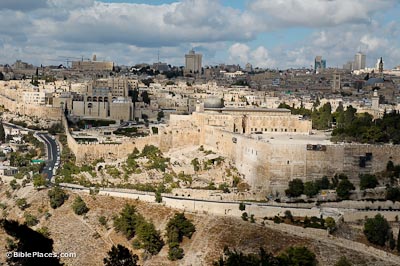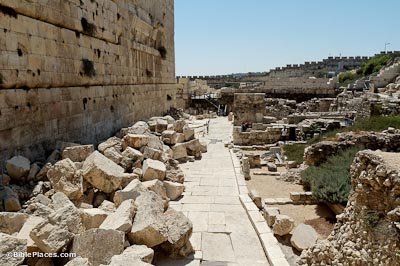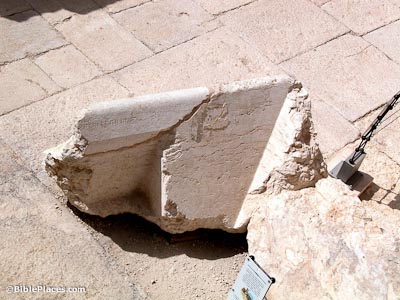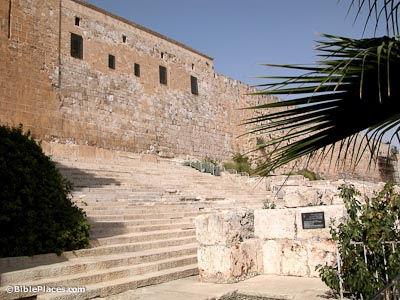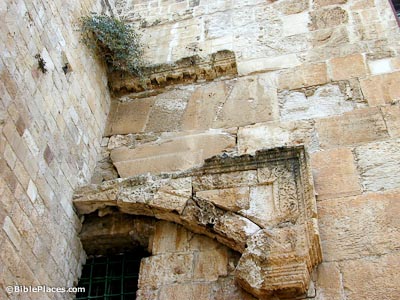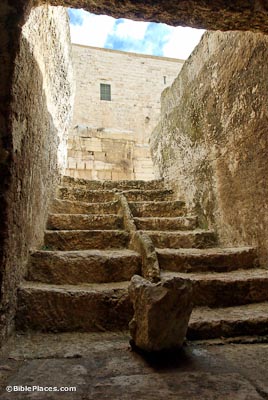These excavations begun by Benjamin Mazar in 1968 were the largest earth-moving archaeological projects in Israel. Work continued until 1978, then resumed in the 1990s under the direction of Ronny Reich. These excavations are the most important for understanding the Temple Mount because of the impossibility of excavating on the mount itself.
Southern Temple Mount
First Century Street
This street was uncovered in the mid-1990s and dates to the decades before the city’s destruction by the Romans in AD 70.
It is 32 feet (10 m) wide and was paved with large slabs up to a foot (0.3 m) thick. The street was covered with massive stones pushed down by the Romans; only part of the street has been fully cleared by the excavators.
Trumpeting Stone
The top stone on the southwest corner of the Temple Mount bore an inscription which read in part, “to the place of trumpeting.” The priests would signal the start of Shabbat and festival days by blowing the shofar from this point. The inscription was apparently only a notice to the construction workers as to the final destination of this specially-cut stone.
Southern Steps
The western flight of stairs leading to the main entrances of the Temple Mount was 200 feet (61 m) wide. Excavators uncovered the easternmost part of this staircase with its alternating long and short steps. Some suggest that the fifteen long steps may have been one of the locations where pilgrims sang the fifteen Psalms of Ascent (120–34) as they went up to worship.
Double Gate
The Double Gates and Triple Gates provided access to the Temple Mount through subterranean passageways. Half of the lintel stone and relieving arch of this Herodian gateway is visible above the later protruding arch. Above and to the right is a stone with an inscription mentioning Hadrian’s son (AD 138). Its position upside down clearly indicates that it is in secondary use.
Mikveh
A series of public ritual bathing installations were found on the south side of the Temple Mount. Because of the demanding laws regarding purity before entering holy places, demand for mikvot was high and many have been discovered from 1st-century Jerusalem. Larger ritual baths such as this one have a small divider wall separating the entrance route from the exit.

Download all of our Jerusalem photos!
$39.00 $49.99 FREE SHIPPING
Related Websites
Related BiblePlaces.com pages: Dome of the Rock and Temple Mount. For historical images of the site, see Life in the Holy Land. The Bible chapters related to the Temple Mount are many, including Matthew 21, Mark 13, Luke 4, and John 2.
The Jerusalem Archaeological Park (All About Jerusalem) This website gives basic visiting information for the archaeological park, accompanied by a few pictures.
Robinson’s Arch (Historical Sites in Israel) Great explanations with pictures to clearly illustrate the subject at hand.
Robinson’s Arch (Jewish Virtual Library) A nice introduction, accompanied by a small reconstruction image.
Herodian Street (Madain Project) This is a wonderful introduction to the street along the western wall and passing under Robinson’s Arch; it includes a few photos as well.
“To the Place of Trumpeting” Stone (Israel Museum) The official museum page about this fascinating artifact, offering a nice photo and plenty of information.
Evidence for the Destruction of Jerusalem in 70AD (Leen Ritmeyer) This gives good information about the siege that destroyed Jerusalem, along with a few supporting archaeological remains.
Solomon’s Stables and the Southern Gates (templemount.org) Detailed scholarly description of this area of the Temple Mount. Focuses mainly on Solomon’s Stables, but also contains good sections on the Southern Gates.
Solomon’s Stables: History and Destruction (Temple Mount Sifting Project) This gives some background to the Solomon’s Stables area. The accompanying video tour can be viewed here.
Ronny Reich (Jerusalem Perspective) A short biography of the man who headed up years of excavations in the southern Temple Mount area.
